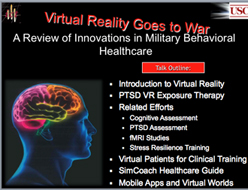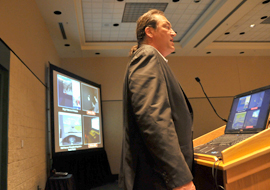American Psychological Association
120th Annual Convention
Orlando, Florida, August 2-5 2012
Virtual Reality Goes to War: Innovations in Military Behavioral Health Care



Invited Plenary Address: Virtual Reality Goes to War: Innovations in Military Behavioral Health Care
Albert "Skip" Rizzo, Ph.D.
Dr. Albert ('Skip') Rizzo began with a brief overview of current Defense Department and Veterans' Administration needs and projects. Framed with the caveat that we all know 'war sucks' in general, the goal here is to do something to help the situation we are in, with the tools and resources we can bring to bear. The nature of war itself has changed, with more survivors of serious injuries. During the Vietnam war, for example, the ratio was 3 wounds to 1 kill among injured soldiers, and now it is 12:1. More people survive their wounds. Of course there are significant numbers of post-war casualties as well, including adjustment problems and suicide.
Some of the current treatments for PTSD , anxiety disorders, and adjustment problems were discussed, within the context of history - how psychological tools and treatments have historically been driven by military applications - such as the Army Alpha tests (and the public's embrace of IQ testing) following World War I , and the birth of clinical psychology during World War II, setting the stage for clinical neuropsychology. Recent military efforts have continued to drive innovation, research and treatment protocols, and stimulated several areas of focus - such as TBI and PTSD - within psychology, psychiatry, medicine, neuropsychology, counseling and rehabilitation.
Dr. Rizzo described 4 specialized labs with which he has been working, as research professor and as associate director of the Institute for Creative Technologies at the University of Southern California. They have been working on a variety of virtual and augmented reality programs, from a 'classroom simulator' to a 'motor rehab lab' with a 3-D environment used with patients recovering from stroke. There are computerized prosthetics, and 'virtual patients' who - through use of artificial intelligence (AI) - are able to help human practitioners and trainees to hone diagnostic and interviewing skills. Although some may at first be skeptical of simulations and AI-based counseling/support applications, several compelling video clips were shown. In one we could watch as an initially reticent interviewer soon 'loosened up' and went with the flow of conversation in the quest for diagnostic information. In another we see an onscreen depiction of a friendly, calm, military man sitting on a porch and explaining in a friendly, folksy manner why he might in fact be helpful: "I'm still just a piece of software, but I'm getting better all the time."
Some history and definitions were shared, terms such as Virtual Reality itself.
[For some definitions, as well as an historical perspective and examples of some diverse mental healthcare applications, please see this report
.]

One of the earliest and most-studied applications has been 'exposure therapy' treatment, using virtual reality. There have been dramatic successes in the treatment of claustrophobia (in Spain), as well as customized treatments for the fear of heights and other well-known phobias.
Some aspects of flat-screen VR are well known now, such as World of Warcraft, and some applications can be deployed very inexpensively now, such as an application for 'upper extremities therapy' which entails a $50 webcam, chopsticks and handballs. More recent and sophisticated applications include things like stereoscopic VR using multiple flat screens and head-mounted displays. Such set-ups "used to cost $350,000 to implement" but can now be done for a fraction of the cost, making it much more accessible.
"We're going from the automated paradigm to leveraging immersion" and naturalistic environments, observed Dr. Rizzo.
Knowledge continues to make advances in terms of both application and customizeability. We've come a long way since the early 90's introduction of computer-based treatments for simple phobias. Now there are treatments which are demonstrably effective, with a wealth of research finding VR treatments to work "as well as in-vivo exposure". In particular, exposure therapy has been amenable to VR-based treatment modalities. For example, there has been some impressive work in a laboratory in Spain focused on treatment of claustrophobia. (Onscreen we can see the animated depiction of a 3-D space with walls which can be manipulated.) In 1994, Rizzo noted, the phobia treatment imagery was not even all that realistic by today's standards, but it worked. Today it is 'virtually better' in every sense. Progress was continuous, with advances in 1995 (fear of heights) and 1997 (fear of flying). In 2000 the graphics started to become much more sophisticated.
>
We see onscreen a literal 3-D replication of an air terminal and airplane, which we can travel through - virtually. Engaging virtual environments, such as this virtual San Diego Airport, provide treatment tools targeting specific fears, such as air travel.
Several research findings are highlighted, such as a 2008 meta-analytical study which compared VR versus real-world/imaginal (exposure) treatment components. Result: the VR modality equaled or surpassed the imaginal in terms of efficacy. "People suspend disbelief and react as if it is the real thing."
Given that among soldiers alone - more than 300,000 or one in 5 in 2008 - are returning home with PTSD, there is a good case to be made for the deployment of such technology-facilitated tools, applied by health/mental health professionals.
A video onscreen goes live, with a loud, percussive battlefield soundtrack and extremely realistic imagery. We hear and practically feel the rat-a-tat-tat of gunburst, and bombs or IEDs exploding in the distance. 'Creepy sounds' too. One needs to have been through it to feel the power fully, but this is realistic enough for today's audience to be impacted by the realism.
Today there are many tailored programs - from the virtual classroom to a 'virtual World Trade Center', along with the Virtual Iraq and Afghanistan environments. More samples from the war situation were shown, replete with the sound of the humvees (vehicles) and the crackle of weapon fire. Multiple senses are engaged here - and additional sensory input channels are now available in some applications as well. The experience - and engagement - can be extremely powerful. Immersive.
Dr. Rizzo emphasized the emotional power evoked here, and the 'need to be sensitive' to it:
One needs to remember, "It's a tool in the hands of a well-trained clinician", not a stand-alone 'clinician of Oz'. It's a clinical interface. A tool.
Several studies were cited demonstrating the success with VR treatments, even where other treatments have failed [e.g., Rizzo et al]. The efficacy of VR-based exposure therapy is so compelling that such treatment is now widely accepted as 'evidence-based'. Meanwhile, researchers are continuously "gathering the evidence, incrementally", across the various treatments and applications.
In terms of particular challenges within 'military healthcare', one obstacle is not so much 'efficacy' as the willingness to seek treatment in the first place, with a common attitude, even if seriously hurting, of "I don't need mental help." One advantage here may be that less public self-exposure is required, and this may foster engagement.
There is also a special advantage of implementing a well-designed program, which is that "once you build a simulator you can repurpose it for a variety of situations" - such as using the Iraq environment as a foundation, with added mountains, for example, to turn it into an Afghanistan simulation. An airport or disaster site or simulated work environment might similarly be adapted for a specific situation. There is additional ongoing research involving the chemistry of behavioral extinction, and use of fMRI imaging [e.g., Roy et al].
Another recent application is in the area of 'stress resilience training' - with the developers' task involving the building of an 'emotional obstacle course'. The training is largely experiential, as opposed to 'death by Powerpoint', and basically emulates the principles of CBT.
Simulated patients with advanced voice recognition increasingly have the ability (via AI) to respond to individual concerns and interests. They are 'intelligent human agents' more than static automated programs. Another example of a training application: Virtual Patients.
Despite some hesitation (apparent in a video clip) we soon see a somewhat stilted interviewer who "starts acting like a real clinician", with this virtual patient. This training module appears at least as effective as more traditional medical/psychiatric practica involving actors. The simulated patients come equipped with sophisticated voice recognition and offer a wide array of individual responses. (Example: A quick and easy response to "Are you a Padres fan?")
And there is SimCoach.
A demonstraton video is onscreen: "Hi there! The name's William... but you can call me Bill." [See Demo Video ]
Here we see another example of virtual-human interview-skill building, as a new virtual character, Ellie, faces a real-life soldier, who seems skeptical and cautious. The soldier asks, 'why should I talk with you?'. Our virtual human replies:
Well, this is private. And you can say what's on your mind. (pause)
"I'd like to ask a few questions so I can figure out how to best help you. Would that be OK?"
Predictably, the soldier is still reticent. But Ellie is both persistent and supportive, knowing the common feeling that nobody can possibly understand the horrors without having personally been there. "I don't want to say I know what you went through because I don't," she acknowledges. But she is there to listen, and maybe it will be helpful. She is non-judgmental, supportive, and empathetic as well, saying at one point, "that must be tough".
Where are we now, and what is our future like? Military funded projects continue and 'the architecture keeps on adapting'. Half the cases of PTSD, meanwhile, have not even been identified. And more and more applications are appearing for education and training purposes - for example SimCoach being used by the Atlanta Braves, and applications to study and modify classroom behavior, particularly inattention.
Augmented Reality, Second Life (virtual seminars and offices), mobile apps, and Virtual Reality: "the ultimate Skinner Box".
And as for war, it is an awful thing, clearly, with many victims, "but we can do what we can to help".
For more on this topic, please see the articles below and the USC-ICT homepage. Additionally, several of these videos can be found on Dr. Rizzo's YouTube channel.
Relevant online references
:
Hans Rosling & Augmented Reality [video/YouTube-BBC]
Avatar-Based Recovery Using Immersive Virtual Environments
Innovative Technologies for Psychological Intervention, Consultation, & Training [Overview of Augmented and Virtual Reality Applications]
Cyberpsychology.com [Tech Advances, Hot Topics, Media Foci, & Psychology]
![[color line]](http://www.fenichel.com/moveline.gif)
2008 Convention Highlights:
Grand Theft Childhood | Opening | Malcolm Gladwell
| College Success, Love, Hate, More |
My Life With Asperger's
My Space, You Tube, Psychotherapy, Relationships... | Aaron T. Beck - 2008 | The Mind and Brain of Voters
2009 Convention Highlights:
Internet: Pathway for Networking, Connecting, and Addiction | Opening | Virtual Psychology & Therapy
| Q&A with Zimbardo
Seligman: Positive Education | Future of Internet Media | Sex, Love, & Psychology |
How Dogs Think
2010 Convention Highlights:
Online Support Groups & Applications |
Evidence & Ethical Practice | Opening Ceremony | Sir Michael Rutter: Resilience
Group Memory | Psychology in the Digital Age | Steven Hayes: What Psychotherapists Have that the World Needs Now
2011 Convention Highlights:
2011: eHealth Odyssey | Googling, Twittering, Poking | Zimbardo: Reflections + Enduring Lessons from 40 Years Ago: Stanford Prison Experiment
Opening | Avatar-based Therapy |
Canine Cognition: Chaser | Aaron T. Beck @90
| Cavanagh: Computerized CBT | Seligman: Flourish
PsychTech: Virtual & Augmented Reality |
Relationships 3.0 | POKE ME: Social Networks & Kids | Telehealth & Telepsychology Licensure - Barriers and Possible Solutions
![[color line]](http://www.fenichel.com/moveline.gif)
![[Current Topics in Psychology]](http://www.fenichel.com/back.gif) CURRENT TOPICS Cyberpsychology APA 2000 2001
2002 2003 2005 2006 2007 2008 2009 2010 2011 2012
CURRENT TOPICS Cyberpsychology APA 2000 2001
2002 2003 2005 2006 2007 2008 2009 2010 2011 2012
Current Topics in Psychology Copyright ©1996-2013 Michael Fenichel
Last Updated: Thursday, 11-Jul-2019 18:53:27 EDT








